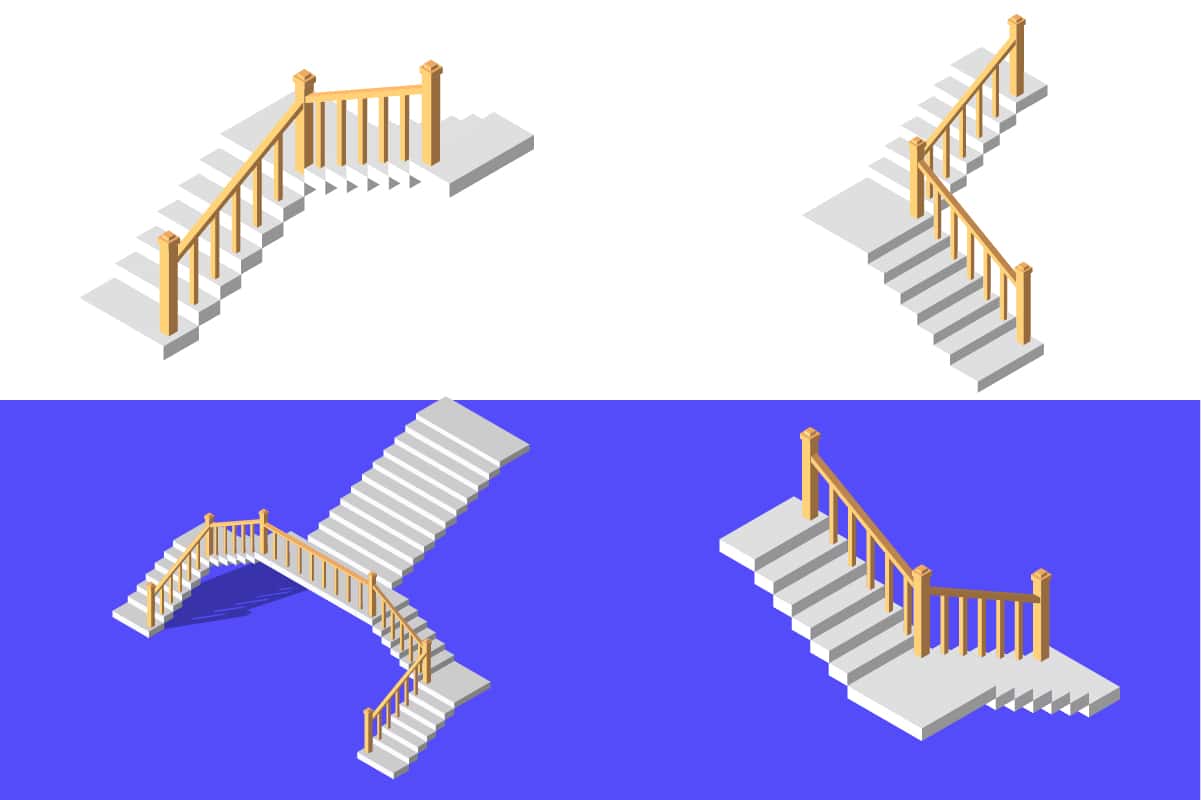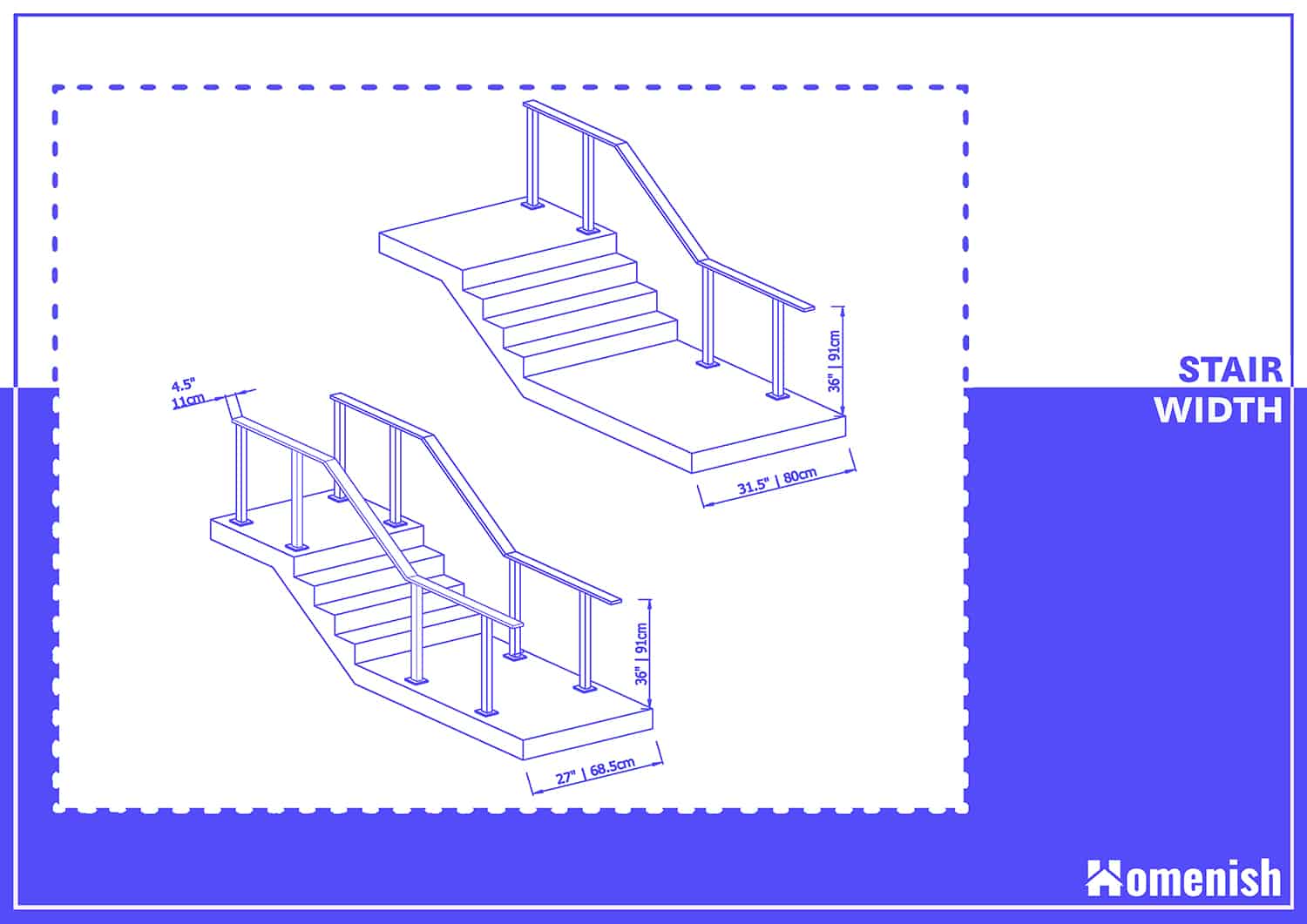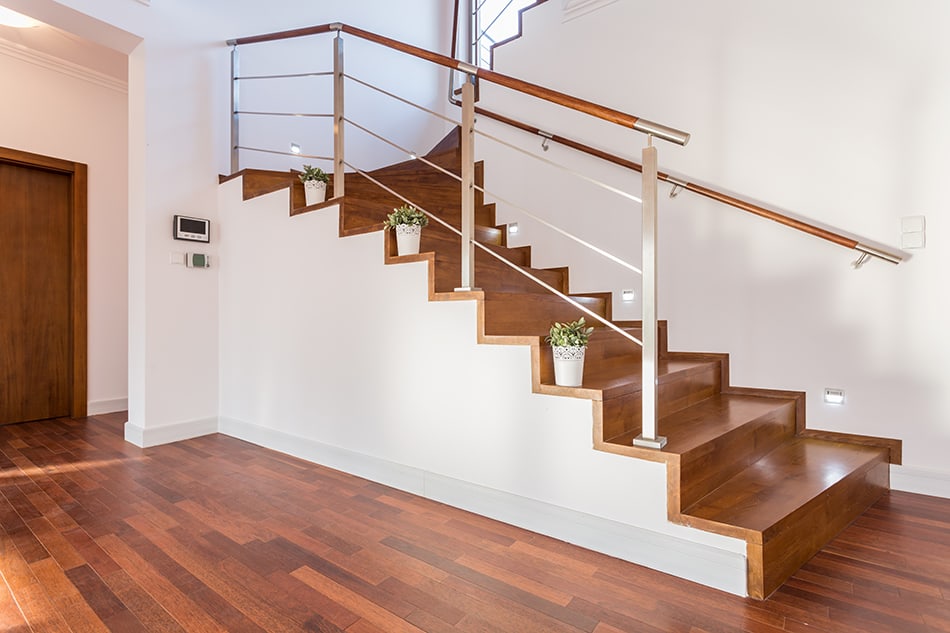Residential stair dimensions and commercial stair dimensions have to conform to building codes, which are strictly implemented to make sure that all users will be safe. When constructing stairs, it’s important to follow building codes not just for safety but also to create a staircase that’s going to stand the test of time and be easy to walk on.
A range of standard dimensions are in place that need to be followed when stairs are designed and built. This includes standard tread length, step height, and the standard dimensions of steps. Here we explore the maximum and minimum space for staircase and the minimum and maximum measurements allowed for each stair component.
Standard Stair Width
If you’re designing a staircase, keep in mind that a staircase that is too narrow is a hazard in various ways. Carrying large objects up and down the stairs could become difficult and can increase the likelihood of falls. Stairs will also need to be wide enough to accommodate a range of people of varying sizes.
Narrow stairs can also be dangerous, especially in the case of emergencies. For instance, if a building is on fire, narrow stairs will hinder people from escaping safely from the building. These potential issues can be avoided by following the recommendations for standard stair width.
The stair width is the distance from one side of a step to the other side, and its standard measurement is at least 36 inches, excluding the handrails. When the handrails are included, they should not take up more than 4 1/2 inches of space.
When a handrail is installed on one side, the clear width of the stair should not be less than 31 1/2 inches. If there are two handrails, the clear width should be at least 27 inches.
These sizes are for normal stairs. For standard spiral staircase dimensions, it should be from 3 feet 6 inches in diameter and a walking path of 17 inches to 6 feet in diameter with a 32-inch walking path. The guidelines for spiral stair installations tend to be different from regular staircases because these can be trickier to navigate.
Vertical Rise and Headroom
Vertical Rise
A staircase should be broken up into reasonable intervals to ensure safety, with a landing roughly every 10 to 16 steps being the standard. The height limit based on the building code should be followed to ensure that the user will be able to take some rest and prevent the negative effects of a continuous staircase.
The rise refers to the overall height of the staircases. Even if stairs come in various shapes, their rise is a vital measurement. The reason is that it allows you to determine where you should place the landing or floor level.
Ideally, a landing must be placed every 12 feet of rise. As such, if the staircase exceeds 12 feet, a landing must be placed in between to break up the stairs. Other than that, there is no requirement for the rise length because staircases can vary. There is also no minimum space for a staircase because you can fit a small staircase into any area you require.
Headroom
Always remember that your staircase should have plenty of headroom so that a person won’t duck down when going up or down the stairs. Plus, having proper headroom will prevent users from hitting their heads when going down the staircase.
The headroom is measured starting from the stair tread to the ceiling above, and it should be at least six feet and eight inches. This will accommodate people of a range of heights.
Stair Tread Depth and Stair Riser Height
Your stairs should be uniform to ensure safety, with each stair tread depth and stair tread length being exactly the same on each step. When the risers or treads have inconsistent measurements, it can interfere with your rhythm when you go up and down the stairs. For this reason, it is imperative that the maximum height of the riser and minimum width of the tread must be followed to achieve the standard dimensions of steps.
Stair Tread Depth
The stair tread is the top surface of a step that you will place your feet on when using the stairs. A stair tread thickness is measured from the front edge of a step to the front edge of the next step. The distance between these two steps should not be less than 10 inches. However, if the steps don’t have nosings but have solid risers, the tread depth should be at least 11 inches.
Keep in mind that the nosing should project a minimum of 3/4 inches and a maximum of 1 1/4 inches from the riser. Additionally, the largest nosing projection should not be more than 3/8 inches than the smallest nosing projection. If you have an open riser, the stair tread depth should be at least 10 inches.
Stair Riser Height
The stair riser is the vertical portion of a step, while the stair riser height refers to the distance between one step to the adjacent step. According to the building codes, the stair riser height should not go beyond 7 3/4 inches.
The maximum stair height is developed so that the stairs will not be too high if you’re going up or not too low if you’re going down. Aside from that, the measurement of all the risers should be identical or close to each other. Plus, the greatest riser height should not exceed the smallest by 3/8 inch for residential stair dimensions.
If your staircase has open risers, the space between the steps should not be large. As much as possible, it should not allow a four-inch sphere to get through; thus, the space between the steps should be less than four inches.
Stair Landings
All stairs must have a landing at the bottom and the top, and its width should not be less than the stair width. Also, its minimum depth should be 36 inches.
Handrails
Code Requirements for Residential Handrails
Handrails have specific codes, and they should have proper graspability, which can either be Type I or Type II.
Type I handrails have parameters of not more than 6 1/4 inches. On the other hand, Type II handrails have parameters of more than 6 1/4 inches.
Stair Handrail Height
Keep in mind that a staircase with four or more risers should have a handrail on one or both sides. The handrail’s height should be about 34 to 38 inches. If the handrail is placed against a wall, it should be at least 1 1/2 inches away from the wall. Lastly, the handrails should cover the full length of the staircases, starting at the bottom riser to the top riser.
Stair Lighting
All staircases should have enough light so that the user will be able to see the steps. As much as possible, there should be a light switch on every floor level, especially if the staircase has six or more risers. A spiral stair installation will be harder to navigate than a standard staircase, so good lighting is especially important for a spiral stair.
Stair Case Calculations
To determine the run of a staircase, you can multiply the tread dimension (excluding the nosing) by the number of steps. If you want to calculate the rise of the staircases, you can multiply the dimension of the step height by the number of steps.
Finally, to determine the number of steps, you can divide the ceiling height in the room by different numbers until you get a reasonable riser dimension. For instance, you can divide the ceiling height by 16. For instance, you can divide the ceiling height by 16. If the result is less than the maximum height of a riser, then your staircase can have 16 steps.








